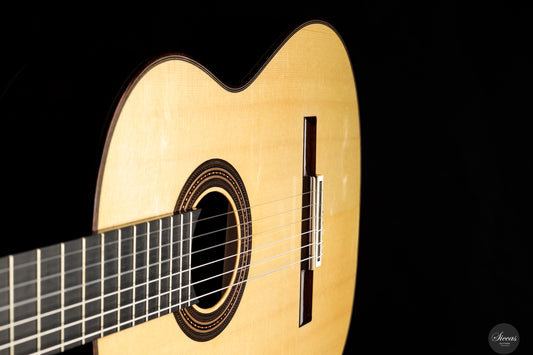
Guitar Tutorial with Matthew McAllister: About filing nails
At Siccas Guitars, we are dedicated to providing valuable insights for classical guitarists of all levels. In our latest video tutorial, world-renowned guitarist Matthew McAllister shares his expert tips on one of the most overlooked aspects of guitar playing—filing nails. For classical guitarists, the condition and shape of the nails are crucial for achieving a clean, articulate sound. In this tutorial, Matthew explains how to properly file your nails to optimize your tone, accuracy, and overall performance.
Why Nail Care is Essential for Classical Guitarists
Classical guitarists rely on the nails of their right hand (or left hand for left-handed players) to pluck the strings and produce a clear, resonant sound. Unlike steel-string or electric guitar players, classical guitarists depend heavily on the nails' shape, length, and smoothness to control their tone and dynamics. Proper nail care can dramatically affect your playing and ensure that your sound is both bright and balanced.
In the tutorial, Matthew emphasizes the importance of having nails that:
- Are well-shaped to avoid catching on the strings or producing an uneven sound.
- Have a smooth finish to ensure a clean release of the string.
- Are the right length to allow for maximum control over dynamics and tone quality.
Nail Filing Techniques Explained
One of the key points in the video is the technique for filing the nails to achieve the perfect shape. Matthew walks through the following steps:
- Determine Your Optimal Nail Shape: Different guitarists prefer different nail shapes depending on their playing style. Some prefer a more rounded shape for a softer sound, while others opt for a flatter or more angled shape to produce a brighter, more focused tone. In the video, Matthew shows how to assess your playing style to find the best nail shape for you.
- Filing Direction: Matthew demonstrates the importance of filing in one direction rather than using a sawing motion, which can weaken the nail. Filing from the edges towards the center ensures a smooth finish and reduces the risk of cracks or splits.
- Smooth the Edges: After shaping the nails, smoothing the edges is crucial for avoiding any roughness that could catch on the strings. McAllister suggests using fine-grit sandpaper or a nail buffer to polish the nail and achieve a sleek, glass-like finish that enhances tone clarity.
- Length Management: Nail length is another factor that significantly affects the guitar tone. Nails that are too long can make the sound harsh, while nails that are too short may limit control over dynamics. In the tutorial, Matthew advises on how to maintain the ideal nail length for precise, controlled playing.
How Nail Shape Affects Sound
The shape of the nails influences how the string is plucked and, in turn, how the sound is produced. Guitarists with rounded nails typically achieve a warmer, fuller tone, while those with sharper or more angled nails produce a brighter, more defined sound. Finding the right balance between these two extremes is key to developing a personal tone that suits your playing style.
Common Mistakes in Nail Care
Matthew also highlights some common mistakes that guitarists make when it comes to nail care:
- Using metal files: Metal files can be too harsh and may cause the nails to weaken or fray. Instead, McAllister recommends using fine-grit emery boards or glass nail files.
- Neglecting regular maintenance: Guitarists should maintain their nails regularly, as small chips or cracks can lead to inconsistent sound or even breakage during performances.
- Not buffing the nails: Leaving nails with rough edges can result in unwanted noise when playing. Smoothing the edges with a buffer is a simple but effective way to prevent this.
Additional Nail Care Tips for Classical Guitarists
For optimal nail health, guitarists should:
- Moisturize regularly: Dry nails are more prone to cracking and splitting, so it's important to keep them moisturized.
- Use nail hardeners: If your nails are naturally soft or prone to breaking, a nail hardener can help strengthen them.
- Consider professional grooming: If you're unsure how to file your nails or maintain them properly, consider visiting a nail technician who understands the needs of classical guitarists.
Watch the Full Tutorial with Matthew McAllister
To learn more about nail care and how it can improve your classical guitar technique, watch the full tutorial with Matthew McAllister. In this video, you'll get a step-by-step guide to nail filing, learn about different nail shapes, and find out how to achieve the perfect tone by simply adjusting your nail care routine.


















